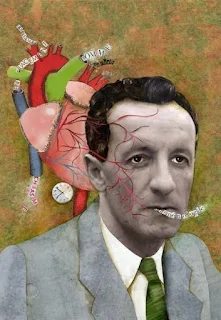Mental history and Mental illness
Mental illness has always been with human history since the past. Unlike prehistoric times, ancient society viewed it as a physical problem, but in the Middle Ages, it was dismissed as a phenomenon of demon possession by evil spirits. However, as the number of people with mental illness increased exponentially during World War II, research on the occurrence of mental illness due to biological causes, which had begun in the 19th century, gained momentum and psychiatry became a specialized field of medicine. In the East, like the ancient West, humans were viewed holistically. Korea had only oriental medicine and folk remedies until the introduction of Western medicine in the late 19th century. Western missionaries and during the Japanese colonial period produced educated Korean psychiatrists, and the enactment of the “Mental Health Act” in 1995 led to the rapid development of psychiatry.(2015. 30-2)
Phenomenology of perception
One of the important concepts in Merleau-Ponty’s philosophy is ‘embodied subjectivity’. He believed that human consciousness and perception are not simply internal mental states, but are formed through continuous interaction between our bodies and the external world. From this perspective, mental illnesses such as schizophrenia are not simply something that ‘happens in the mind,’ but can be understood as a problem of an individual’s physicality, perception, and interaction with the environment. Psychosomatic medicine was greatly influenced by Merleau-Ponty.
“ « l'expérience de l'espace est entrelacée... avec tous les autres modes d'expériences et toutes les autres données psychiques ». L'espace clair, cet honnête espace où tous les objets ont la même importance et le même droit à exister, est non seulement entouré, mais encore pénétré de part en part d'une autre spatialité que les variations morbides révèlent. Un schizophrène à la montagne s'arrête devant un paysage. Après un moment, il se sent comme menacé. Il nait en lui un intérêt spécial pour tout ce qui l'entoure, comme si une question lui était posée du dehors à laquelle il ne pût trouver aucune réponse. Soudain le paysage lui est ravi par une force étrangère. C'est comme si un second ciel noir, sans limite, pénétrait le ciel bleu du soir. Ce nouveau ciel est vide « fin, invisible, effrayant ». Tantôt il se meut dans le paysage d'automne et tantôt le paysage lui aussi se meut. Et pendant ce temps, dit le malade, « une question permanente se pose à moi; c'est comme un ordre de me reposer ou de mourir, ou d'aller plus loin ». Ce second espace à travers l'espace visible, c'est celui que compose à chaque moment notre manière propre de projeter le monde et le trouble du schizophrène consiste seulement en ceci que ce projet perpétuel se dissocie du monde objectif tel qu'il est encore offert par la perception et se retire pour ainsi dire en lui-même. L'a schizophrène ne vit plus dans le monde commun, mais dans un monde privé, il ne va plus jusqu'à l'espace géographique: il demeure dans « l'espace de paysage » et ce paysage lui-même, une fois coupé du monde commun, est considérablement appauvri. De là l'interrogation schizophrénique : tout est étonnant, absurde ou irréel, parce que le mouvement de l'existence vers les choses n'a plus son énergie, qu'il s'apparaît dans sa contingence et que le monde ne va plus de soi.”(PHP. 332. ed. Merleau-Ponty explains the interrelationship with the world through the spatiality of the body-subject using the example of a schizophrenic patient.)
Patients with schizophrenia are open to the world as body-subjects. But, that's just his world. What we can see here is that mental illness is closely connected to the body. Whether it is a biological cause or a psychological mechanism, humans cannot uncover reality apart from the body. The quote above describes a special moment a schizophrenic patient experiences in the mountains. Patients take a special interest in everything around them and experience a feeling as if questions are being asked from the outside. This experience is threatening to the patient, who feels that he or she exists in a different kind of space than a normal space. These spaces are “second spaces,” penetrating visible space and are described as deeper, opaque, and infinite.
According to Merleau-Ponty, these experiences indicate that the schizophrenic no longer lives in a communal world, but instead lives in his or her own personal world, the “space of the landscape.” These spaces are cut off from the common world and become much poorer as a result. This disconnection from the world makes everything the patient experiences seem surprising, absurd, or unrealistic. Because the movement of the patient's being is no longer directed towards the world, but his being appears to himself through the awareness of contingency.
[Reference]
- M. Merleau-ponty, Phénoménologie de la perception(abb. PHP), Éditions Gallimard, 1945.
- 민성길, 『최신정신의학』, 일조각, 2015.

Comments
Post a Comment